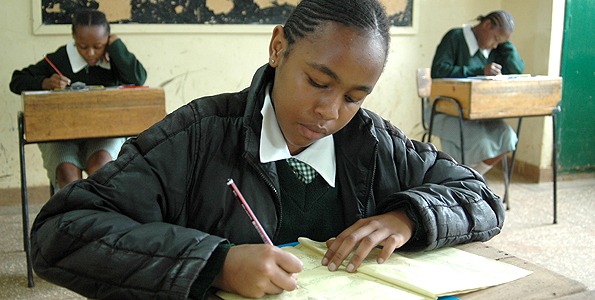
By Alexandra Esnouf
In 2003, when Mwai Kibaki assumed presidency under the National Rainbow Coalition, one of the first projects he commanded was to make primary education in Kenya free and compulsory for all boys and girls. This constitutional change was pressing, for enrollment rates presented by The World Bank show that, in 2002 they were merely 62%, and after it was implemented these rose to 112% in 2009, exceeding 100% since it includes adults and other citizens who had previously not had access. Additionally, the Human Development Education Index data reflects the impact of this change in numbers, where since 2003 Kenya’s Education Index has increased progressively, reaching a standpoint in 2009, which has maintained till 2013.
The novelty and necessity of this free education reached such an extent that Kimani Maruge, at the age of 84, became the oldest person to ever enroll and complete primary education, gaining him a place in the Guinness World Records.
Like him, many others have taken advantage of this opportunity. Nevertheless, Kenya ranks 9th amongst countries with the highest rates for children who are not enrolled in primary education worldwide, according to UNESCO’s 2012 fact sheet on Education in Kenya. Numerically, it claims there are a million students who are out of school without access to this benefit.
Despite these numbers, those students who do manage to attend school and to complete their studies finalize their passing through primary school by sitting exams to attain the Kenyan Certificate of Primary Education (KCPE). After 8 years of primary school, starting at the age of 6 and ending at 14 (assuming the student fulfilled each year’s standards accordingly), students must take examinations in a variety of subjects, which will then provide them with a single overall score. This score is fundamental in deciding whether the student will be capable of progressing further with their education, as it is the factor that determines if secondary school is an option.
But KCPE criticisms are not only related to what happens after receiving the results, as the continuation of education post primary schools is more related to the free education law which was limited from developing its full potential from the start, as there are significantly less secondary schools in Kenya than elementary schools. Regarding the KCPE specifically, the pressure on schools and on students is beyond manageable, as all results are made public, creating unhealthy competition amongst peers; the focus on standardized exams is esteemed as unfair and inadequate in a system where the quality of education is decadent, and the differences of quality amongst schools is immense; if students fail the KCPE, they are not allowed to retake classes; the examination fees are not accessible to all, so students who have attended primary school throughout are unable to be evaluated; if schools don’t pay their dues, the school closes and blocks those students chance of sitting the exam; students are transferred to sit the KCPE at other schools to manipulate the KCPE results ranking. Each one of these flaws opens up into a whole discussion, which has become know as the anti-KCPE debate.
The Kenyan government is headed in the right direction by providing free primary education to all its boys and girls. But the basic structure of its system has important flaws, most of which are reduced to or related in important ways to the KCPE, and that will impede any other modification or reform the government implements. And so, it is imminent that the transition between primary school and secondary school is smooth and accessible to all, but at this point the KCPE seems to be the determining factor for this changeover, and it is an enigma yet to be resolved.
Alexandra Esnouf ’17 is in Branford College. She is a beat blogger for the Globalist Notebook. Contact her at alexandra.esnouf@yale.edu.